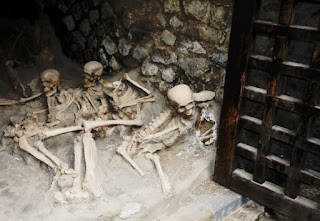Forensic Anthropology and Darwinian Racism
Although evolutionists try to distance themselves from their racist past, it has been a serious problem since the Bearded Buddha published his tomes. Not all of the public has been fooled by denials of evolution supports. Elements of racism in evolutionary studies are found even today.
An area that could be severely damaged is forensic anthropology. (The television show Bones was loosely based on a real forensic anthropologist, portrayed by Emily Deschanel.) Forensic anthropology can be used to determine a victim's race.
 |
| Skeletons in the' Boat Houses', Herculaneum, Flickr / Big Albert (Public Domain) |
If enough material is present, forensic anthropologists can determine with a high degree of accuracy the size, sex, and other details regarding the victim. This is where we clarify something: God created only one race. There are no "races", but the term is used as a convenience despite its flawed evolutionary background. More realistically (and biblically), there are people groups or ethnicities.
Some people are offended because anthropology has been used for racist purposes, so they want to put a stop to forensic anthropology. This would be yet another way that evolutionary thinking has hindered modern science — and solving crimes as well.
What really takes the rag off the bush is that evolutionists are so locked into preserving their narrative and injecting a dose of Darwin into almost everything, they want to use the problem to fix the problem! (May as well ask if McVeigh wants more fertilizer, it makes just as much sense.) However, some good may come out of the concerns raised by the public — yet racist Darwin still has not been removed by cancel culture zealots. Go figure.
When teaching college-level forensics, I showed a film on how a murderer was identified and convicted in court from a skull and a few remnants of clothing. To explain how the forensic anthropologist worked, the film showed in detail how the entire face was constructed from the skull which they estimated had died about 5 years ago. Markers were used to determine the thickness of various skull parts to help place the correct amount of clay that represented muscle tissue on each section of the skull. Then, using the skull to determine probable racial traits, such as eye and hair color, the head was finished in such detail that it looked like a photograph of the deceased person, which was confirmed when the murdered woman was found.
The next step was to display the finished product on local television, and when this was not successful, to display her likeness on television in other areas of the country. Soon, a state away, a person identified the woman. . .
To read the rest of this fascinating article, click on "Using Race to Identify Skeletal Remains."